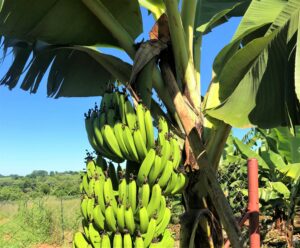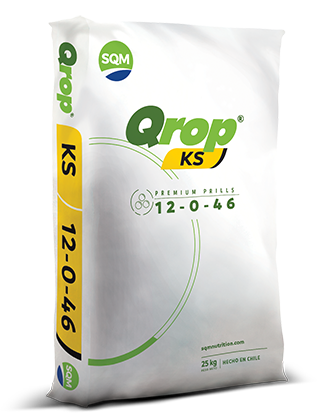Banana cultivation is of vital importance for the local economy in many tropical regions. Ecuador is one of the world’s major exporters of bananas, accounting for 30% (82 million boxes of 19,5 kg each) of the global supply in 2015 according to the Ecuadorian banana exporters association (AEBE). This represents 15% of the total exports from the country.
The majority of the Ecuadorian banana producers apply on average 400 kg N, 100 kg P2O5 and 500 kg K2O per hectare, divided over 6-12 applications per crop cycle. These nutrients are routinely applied as urea, DAP and KCl. Occasionally producers use ammonium nitrate, ammonium sulphate or potassium sulphate. Only some producers apply micronutrients and more specialized granular NPK formulas.
The plantations of banana are mostly located in the coast region: almost 80% of the total surface of 180.000 ha is found in the provinces Los Rios, El Oro and Guayas. The province of El Oro contains the second largest surface of banana plantations in Ecuador, but suffers from relatively low yields (less than 2000 boxes/ha/yr). Three aspects of nutrient mismanagement can explain this low production:
- On average the N, P and K applications are 300 kg N/ha, 100 kg P2O5/ha and 400 kg K2O/ha, and this is lower than recommended based on the nutrient removal by the crop.
- The production is compromised by excessive application of chloride in the traditional programmes with KCl delivering up to 80% of the total annual potassium fertilisation.
- The proportion of export quality fruit is low due to deficiencies in K, Ca and Mg.
The producers are not aware of the potential of application of chloride free, potassium nitrate based NPK formulas to improve these three aspects, and increase crop productivity and quality.
SQM Ecuador developed the use of Qrop® Complex Top K (12-6-24) in El Oro, resulting in a significantly improved quality and yield of the crop. Qrop® Complex Top K provides chloride-free and well-balanced nutrients replacing the use of ammonium nitrate and potassium chloride.
To show the benefits of the SQM programme based on Qrop® Complex Top K, a trial was conducted in the province of El Oro, at the Hacienda Agricultosa, On 144 ha of Cavendish cv Williams (1400 plants/ha) the fertilisers used in the trial were applied manually at the foot of the developing suckers. Each 5 weeks 250 kg/ha (179 g/plant) of Qrop® Complex Top K was applied, starting in July 2016. Table 1 compares the NPK supplied in the farm practice, with NPK supplied by Qrop® Complex Top K.
Table 1. Total NPK applied with the farm practice including ammonium nitrate and KCl, and with Qrop® Complex Top K in El Guabo – Ecuador 2016.

A number of yield parameters were registered:
- Yield in the number of boxes of export quality/ha/wk.
- Ratio: The number of bunches per box.
- Weight per bunch.
- Number of hands per bunch.
- The number of clusters per box: The hands are divided in clusters of a set number of fingers that is specified by the exporter. The parameter refers to the number of clusters that is needed to fill the box to the required 19,5 kg (43 lb).
Preliminary results of the first 4 application cycles that were collected till November 2016 are reported here (Table 2). The trial will be continued for at least 6 more cycles.
First results are promising and show an increase of yield and quality of the fruits by use of Qrop® Complex Top K, even when the evaluated bunches were still formed partially with nutrients supplied with the traditional fertiliser program. Over the trial period, the average number of boxes/ha/yr has increased by 12,5%. At the start of the programme in week 30 one bunch filled on average 1,1 boxes, and this ratio had increased to 1,2 by week 45. Also the average weight of the bunches has increased by 26% since the start of the trial. In addition the average number of hands per cluster was higher.
At the first application of Qrop® Complex Top K, one box was filled with 20 clusters, and 15 weeks later, this had dropped to 17: this is directly proportional to the increase in the number of boxes/ha.
Table 2. The increase in yield of bananas Cavendish (cv Williams) by use of Qrop® Complex Top K after 4 application cycles.

Since the farmer is paid by box, this higher yield directly benefits the income of the farmer, with a projected increase of his gross margin with 742 USD/ha/yr resulting from adoption of the use of Qrop® Complex Top K (Table 3).
Table 3. The use of Qrop® Complex Top K increased the earnings and gross margin.

Based on the first results of the trial, the customer has decided to adopt the following improvements of his current fertiliser practice:
- He has made the radical decision for 2017 to eliminate potassium chloride from the system, to minimize the use of ammonium, to increase N to 400 kg/ha/yr, and to increase K from 600 to 700 kg K2O/ha/yr. This increase of potassium will be realized with extra potassium sulphate. The supply of phosphorus will be maintained at 150 kg/ha of P2O5 delivered by Qrop® Complex Top K at 2,5 MT/ ha/yr.
- The customer replaces the use of physical mixtures by Qrop® Complex Top K, with its NPK + micronutrient composition providing the majority of the nutrients needed in order to obtain the higher yield in the quality that interests him.
- Calcium might not be provided satisfactorily with Qrop® Complex Top K. Although there are no symptoms of calcium deficiency in the crop, the customer noticed a drop in foliar Ca levels. He plans to apply at least 100 kg of TROPICOTE (15,5% N + 26% CaO) per ha in February.




